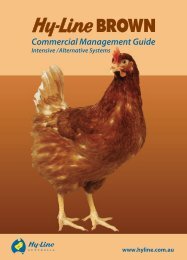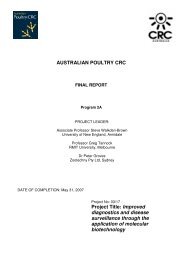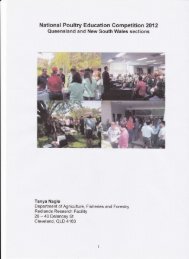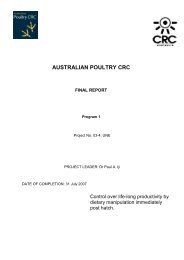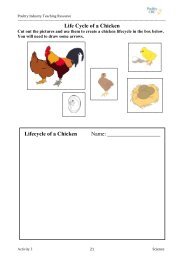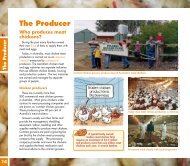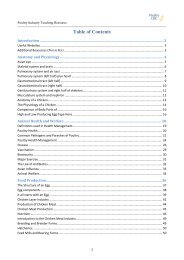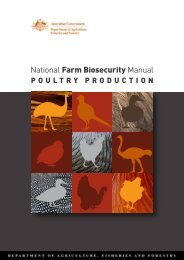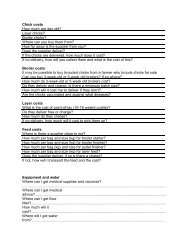AUSTRALIAN POULTRY CRC - Poultry Hub
AUSTRALIAN POULTRY CRC - Poultry Hub
AUSTRALIAN POULTRY CRC - Poultry Hub
- No tags were found...
You also want an ePaper? Increase the reach of your titles
YUMPU automatically turns print PDFs into web optimized ePapers that Google loves.
ResultsNationwide SurveyGeneralFourteen free range producers replied to the nationwide survey, five from Queensland, one from NewSouth Wales, and four each from South Australia and Victoria. Six of the poultry farms had beenoperational for less than 10 years, three for 10 - 20 years, 4 for 21 - 50 years and one for more than 50years. However when asked how long they were operating as a free range farm, one farm inQueensland that had been a poultry farm for more than 50 years had only been a free range farm forless than 10 years. The producer from New South Wales had also been in the poultry industry for 21 -50 years however had only had free range poultry for 10 - 20 years. The average number of free rangelayer hens per producer per year ranged from less than 1000 (6 producers) to 50 000 - 100 000 (1producer), with the number of sheds per farm ranging from less than five (10 producers) to between 21and 35 (2 producers). Forty-three percent of farms had a maximum of less than 500 layers per shed,with 7% having between 501 – 1000 layers per shed, 29% having 1001 – 300l layers per shed and 21%having more than 3001 layers per shed. The size of range area available ranged from 100 m 2 to 2500acres.All farms had wild birds regularly visiting (table 2) with 9 farms having water courses/dams on theproperty.Table 2: Wild birds regularly visiting free range farms in Australia.HousingNumber of farmsType Summer Autumn Winter SpringDucks 3 4 4 3Magpies 9 9 9 10Crows 11 9 9 11Mynas 4 4 3 3Hawks 9 9 9 10Eagles 8 6 5 8Ibis 4 4 3 4Plovers 5 4 4 4Kookaburras 7 7 7 7Swallows 6 3 3 8Pigeons 7 7 7 7Swamp wading birds 1 1 1 1Ravens 2 2 2 2Sparrows 1 1 1 1Thirteen of the 14 farms had conventional sheds made of metal and timber with two farms havingigloo type sheds, one made of canvas and one of polypropylene. Of the 10 farms that had permanentlyfixed sheds, only three used pasture rotation. Victoria and South Australia had some farms withmobile sheds and movement of these sheds ranged from every couple of days to 5 weeks. Twoproducers used automatic nest boxes with the remaining farms using individual or colony nest boxesthat required manual pick up. Nest boxes were made of wood (4 producers), metal (9 producers) andplastic (4 producers). One producer in South Australia used slats, with all other producers using eitherA-frame or single level perches.11



